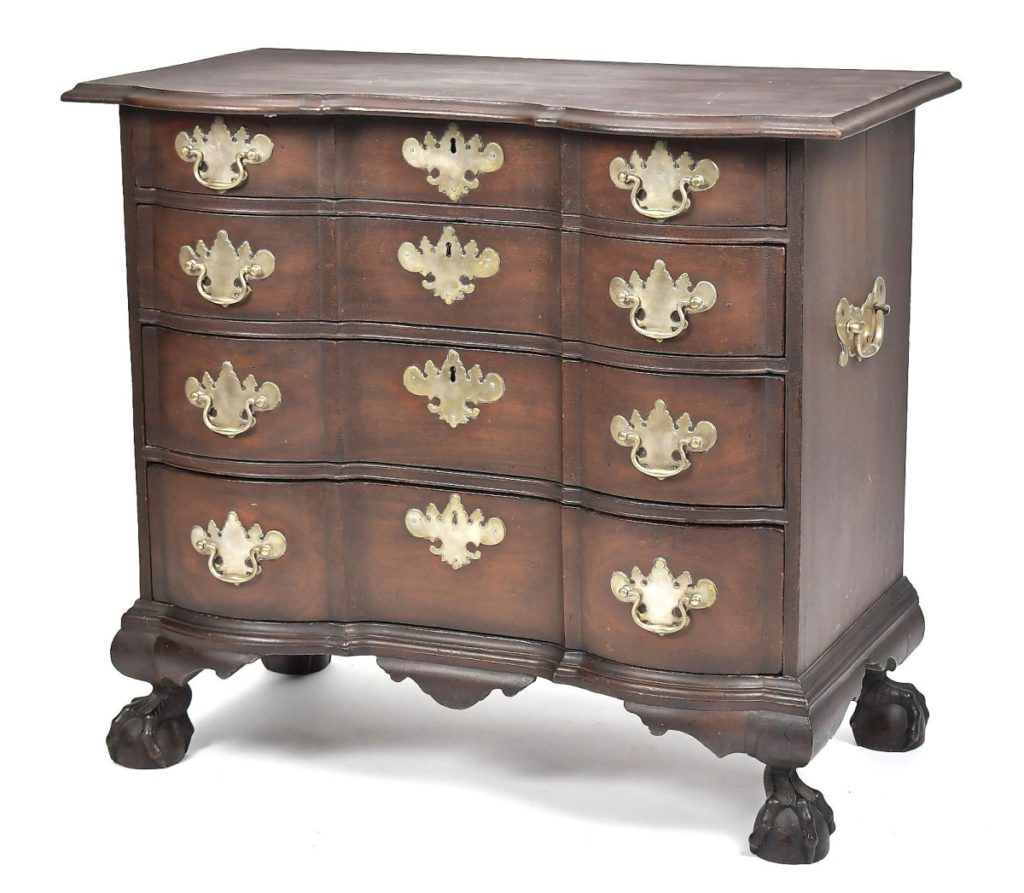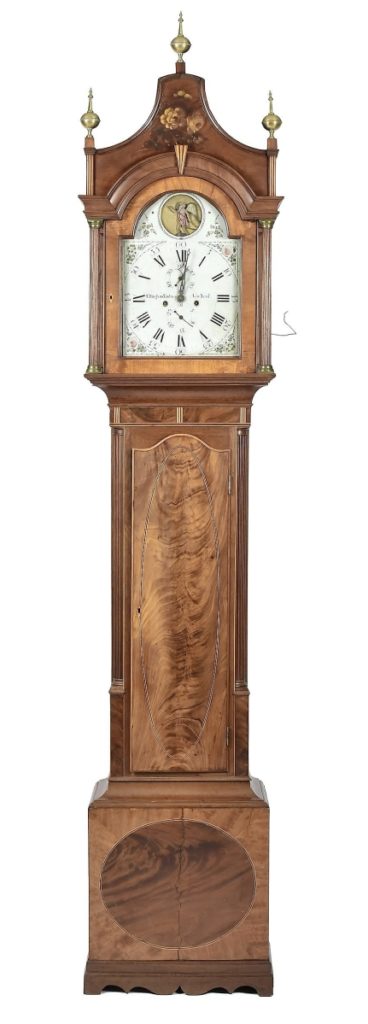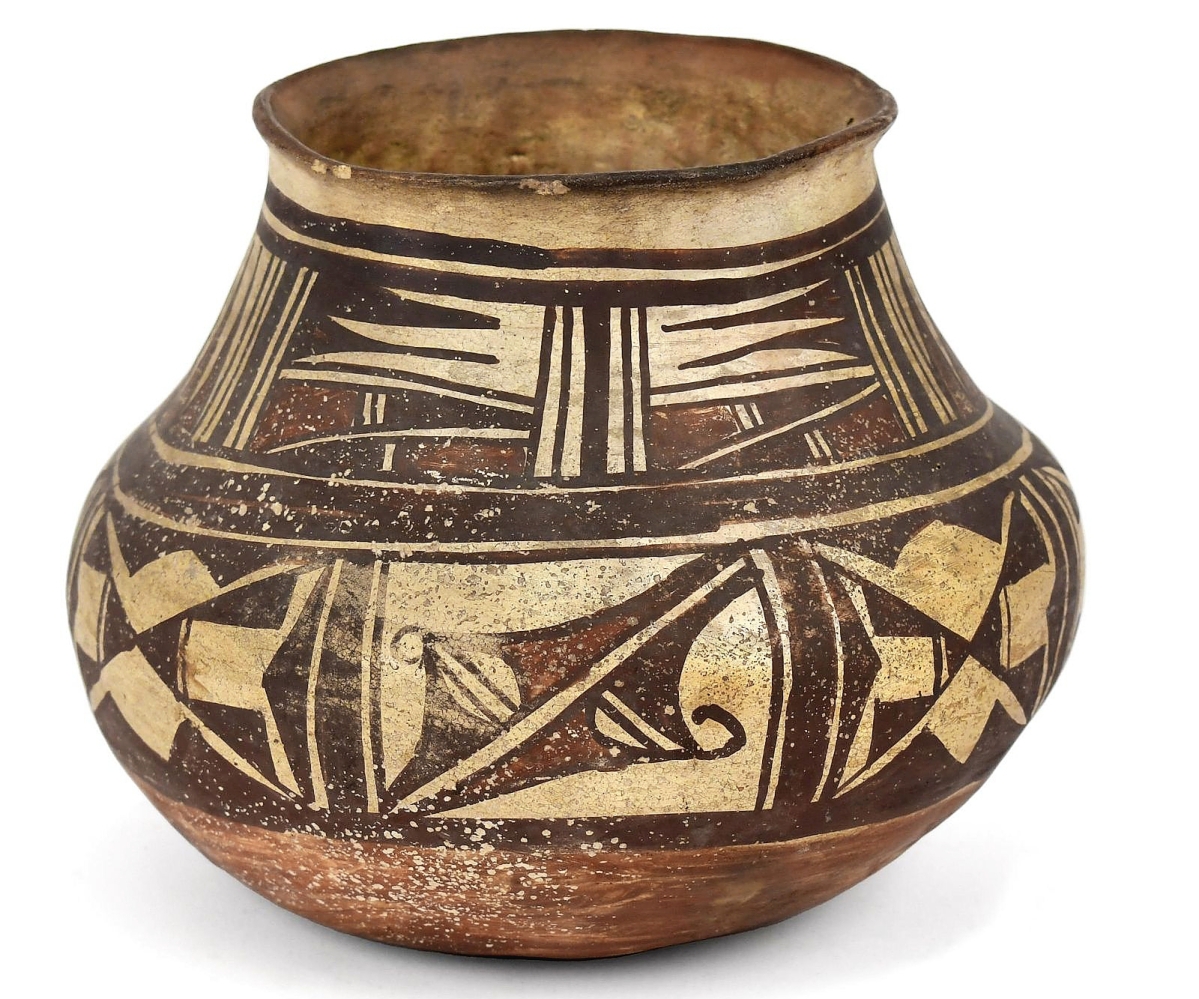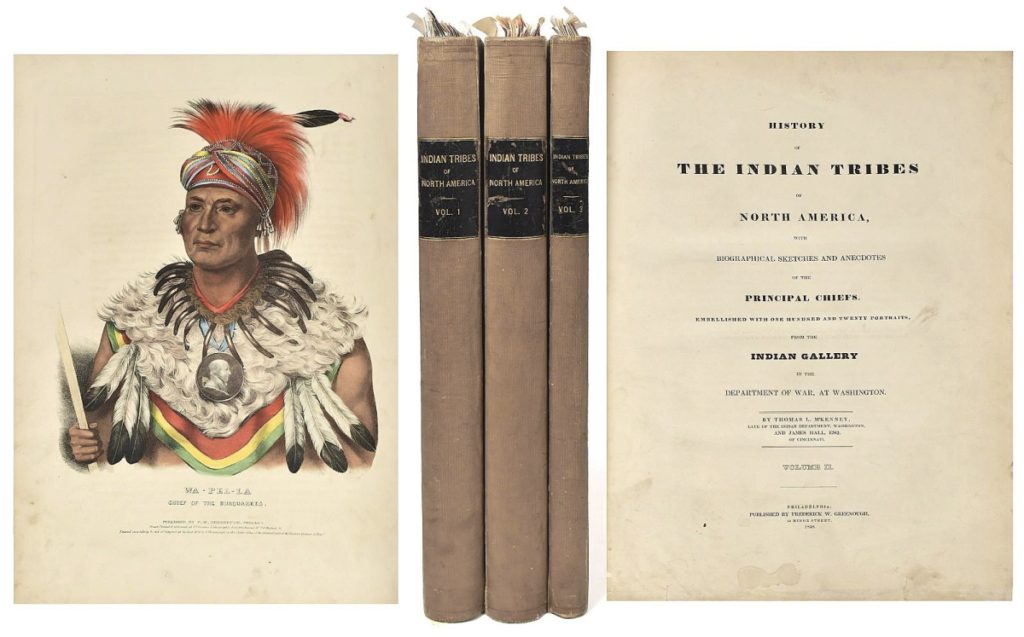American Furniture, Paintings And Chinese Works Earn $900,000 At Bill Smith’s

This circa 1760-80 Boston rounded block-front four-drawer chest was the highest priced item in the sale. It was in almost untouched condition, had original silvered hardware and finished at $42,000.
Review and Onsite Photos by Rick Russack, Catalog Photos Courtesy W.A. Smith
PLAINFIELD, N.H. – Top price for a piece of Massachusetts furniture: $42,000. Top price for a piece of New Hampshire furniture: $24,000. Top price for an American painting: $30,000. Top price for redware: $9,000. Top price for an Asian item: $19,200. It was that kind of a day at William A. “Bill” Smith’s February 22 sale. Smith got a lucky break weatherwise for his live Winter Auction, which exceeded a little more than $900,000. It snowed both the day before and after the sale but the day of the auction was just a normal New Hampshire winter day.
The sale was strong, with desirable examples of New Hampshire and Massachusetts furniture and several more American paintings by White Mountain and Hudson River artists, along with more recent works. There was also silver, European furniture and porcelains, as well as additional Asian items, including several Oriental carpets. When the auction had ended, a dozen items had sold for more than $10,000. There were about 100 bidders in the room, plus very active internet, phone and absentee bidding. Bidders who are unable to view items in person can rely on Smith’s online descriptions, with condition reports, and often as many as ten photos per lot.
The highest priced item in the sale, earning $42,000, was a circa 1760-80 Boston rounded block-front four-drawer chest. It was cataloged as “old color/finish with original silvered hardware,” but there were three bidders in the gallery who thought it was even better. The purchaser, a long-time collector/dealer from New Hampshire who asked that we not use his name, had said before the sale, “It’s just a wonderful example and it’s the best I’ve ever seen. Absolutely nothing has been done to it. The finish is original, and there’s no damage to the case and there have never been any repairs. Even the hardware is special. They’re large, heavy drawer pulls and they’ve been silverplated. They’re not done that way originally – the cabinetmaker had that done especially for this chest. It’s just a wonderful piece.” After the sale he said, “I hadn’t planned on going that high but I’m very glad I stayed with it.” Two underbidders were also from New Hampshire. One went up to $30,000 and the other stayed with it until finally one more bid was more that he wanted to spend. “Maybe there’ll be another but this was really a good one.” The 11 online photos showed the chest from all angles, including the bottom, a close-up of the hardware and a closeup of a drawer.

The brass works and painted iron dial of this circa 1800 Federal mahogany tall case clock were signed “Effingham Embree New York.” The bracket base had been restored on the 8½-foot-tall clock, which earned $9,000.
The third highest price of the sale, $24,000, was realized by a rare 1780-95 maple New Hampshire Queen Anne highboy in untouched, original condition. It was bought by Phil Zea, bidding on behalf of the New Hampshire Historical Society. The extensive catalog description attributed the piece to a cabinetmaker in the area of Chester, N.H. “The maker of this piece appears to have learned his trade in the Merrimack Valley in the shadow of the Scots-Irish craftsman John Dunlap of Goffstown and Bedford N.H. That’s displayed in the heavy massing of the casework, deep cornice, tri-part drawer configuration at top, and use of multiple drawer facades to conceal a single long drawer in the case. It descended in the 1743 home of the Wason family of Chester, N.H. Family history states this highboy was made by the husband of Lucretia Day, as a wedding gift to her sister Dorothy Worthen. Dorothy married James Wason on September 3, 1802.” The catalog speculated that it had never been moved from that home because of its condition.
A circa 1800 tall case clock with brass works and painted iron dial signed Effingham Embree New York, sold for $9,000. At the top of the arched dial, “Father Time” moved back and forth as the pendulum swung. Embree worked in New York from 1781 to 1797; one of his clocks is in the White House, another is at Winterthur and another is at the Henry Ford Museum. Boscobel writes of their example, “Effingham Embree is one of New York’s most celebrated makers of clocks and watches just after the Revolutionary War, when stately timepieces were not merely impressive furnishings, they were economic investments for merchants, shippers and other professions.”
Buyers of New Hampshire furniture had several opportunities. A circa 1820-30 New Hampshire Federal period solid birch chest, inlaid with flame birch drawer fronts sold for $5,700. A period New Hampshire Queen Anne highboy, circa 1760-80, with all the earmarks of having been made by the Dunlap family went out at $5,100. Country furniture was well represented by an Eighteenth Century two-part red-painted pine set back cupboard, with two doors each containing six panes of wavy glass; it earned $4,200. While most of the furniture was Eighteenth and early Nineteenth Century, a circa 1880 mahogany desk with two chairs, all heavily carved and attributed to R.J. Horner, achieved $4,500.

This early Acoma olla by an unknown maker topped off at $2,040.
There were several high-selling American paintings, covering a broad time period. The sale’s second highest price, $30,000, was achieved by a landscape scene of travelers on a path in the White Mountains by David Johnson (1827-1908), whose Hudson River scene sold for $13,200. Other White Mountain paintings by artists included Benjamin Champney (1817-1907), Frank Shapleigh (1842-1906), and Samuel Lancaster Gerry (1813-1891) in the sale. The Champney sold for $5,700. One of the quintessential barn scenes by Shapleigh brought $3,840. Gerry’s landscape realized $6,000. An autumn Hudson River scene by Jasper F. Cropsey (1823-1900) brought $19,200. Alfred T. Bricher’s “Lake George From Bolton” sailed to $16,800. A Pennyslvania Impressionist winter landscape by Antonio P. Martino (1902-1988) achieved $12,000. Of the later American paintings, a colorful abstract acrylic by Robert Natkin (1930-2010) earned $22,800. Another acrylic by the same artist earned $3,480.
There was only one Chinese export style painting in the sale. It depicted the fully rigged British ship Norfolk with several other ships nearby. Bearing a paper label “Hingqua” and in an old and possibly original frame, it sold for $2,280.
Several Asian items did well and pointed out the difficulty of predicting prices for desirable pieces. For example, two small bowls in a fitted case, described as a “pair of light green incised Chinese celadon porcelain bowls, each with under glazed blue chop mark on bottom,” were expected to sell between $400 and $600. They finished at $19,200. A seven-piece porcelain lot described as “a group of Twentieth Century Chinese celadon porcelain,” with similar presale expectations, sold for $14,400. Drawing strong presale interest, a small Chinese cloisonne and intricately carved jade box was believed to be from the late Nineteenth Century but it may have been older as it sold for $7,800.

Three folio sized volumes of McKenney and Hall’s History of the Indian Tribes of North America brought $18,000. Published in 1838, 1842 and 1844 in Philadelphia, each of the volumes had been rebound. Twelve of the original 120 plates were missing and others had been repaired.
Smith’s sales often include European furniture; this auction did, and many such pieces did well. A large walnut Louis XV period French armchair with solid carved sides and early tapestry upholstery sold for $3,120. A large oak Eighteenth Century English Welsh dresser with shelves in the top section and several drawers sold for $2,760. It was 83 inches tall, 67 inches wide and had a good patina. An inlaid Eighteenth Century George II burl walnut chest-on-chest brought $1,920. A set of 10 George III Hepplewhite mahogany dining chairs, with pierced carved backs, recently reupholstered, sold for $1,800.
After the sale, Smith said, “diversity of material is what makes a sale work these days and we had that. Good American furniture, folk art, very good paintings and good Asian ceramics. I knew the furniture and the paintings would do well – they matched up well with our clientele. The Chinese porcelains were a surprise, but a nice one. The consignor had been watching the sale, which we live-streamed, and was more than delighted with the results. That just shows how the internet gets stuff in front of the right buyers. We didn’t pass many things and the total, just a bit under $900,000, was a good result. Our next good live Americana sale will be around Memorial Day.”
Prices quoted include the buyer’s premium as reported by the auction house.
For information, 603-675-2549 or www.smithauction.com.
